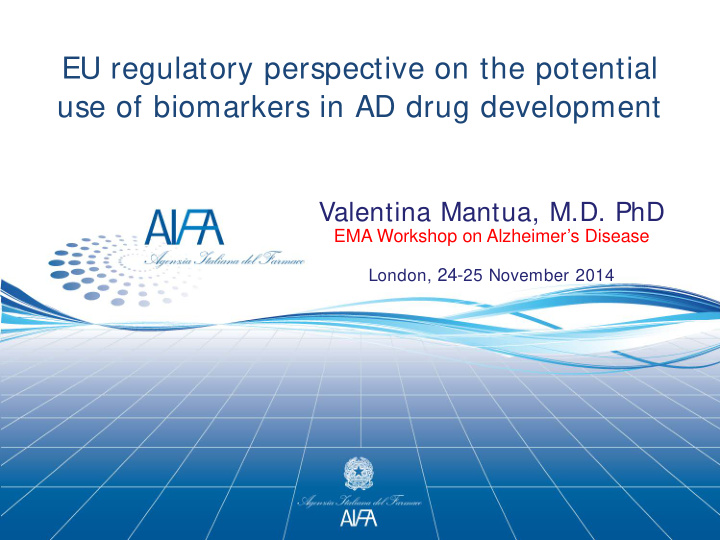



EU regulatory perspective on the potential use of biomarkers in AD drug development Valentina Mantua, M.D. PhD EMA Workshop on Alzheimer’s Disease London, 24- 25 November 2014
Public Declaration of transparency/interests* More than 2 More than 5 years but Interests in pharmaceutical industry NO Currently Last 2 years years ago less than 5 (optional) years ago Direct interests: Employment with a company X Consultancy for a company X Strategic advisory role for a company X Financial interests X Ownership of a patent X Indirect interests: Principal investigator X Investigator X Individual’s Institution/Organisation receives a grant X or other funding CME Courses X * Valentina Mantua , in accordance with the Conflict of Interest Regulations approved by AIFA Board of Directors (26.01.2012) and published in the Italian Government Official Journal on 20.03.2012 according to 0044 EMA/513078/2010 on the handling of the conflicts of interest for scientific committee members and experts Note: For this presentation I am not receiving any compensation
Why is AD a regulatory challenge? • Animal models do not reflect human pathophisiology of the disease • Diagnosis can be formulated in vivo with less probability in early stages • Trial design is not optimized to detect significant changes in milder patients • Biomarkers change role in the different phases of development • Disease modification definition relies on uncertain biological evidence
Biomarkers in drug development • Target engagement • Proof of mechanism • Proof of concept • Enrichment • Diagnosis (supportive or mandatory) • Outcome (supportive) • Outcome (disease modification)
Target engagement/proof of mechanism > > > The value and qualification of several biomarkers has been improved considerably and some of them may be used as primary endpoint in proof of mechanism/principle studies > > > Plasma and CSF Aβ species • Agents directly targeting Aβ deposition by Amyloid load at PET active and passive immunization • Agents targeting Aβ accumulation via inhibition Plasma and CSF levels of Aβ42, Aβ40, sAPPβ (dose - or modulation of the γ -secretase APP cleaving dependent) enzyme and β -secretase cleavage enzyme BACE1
Proof of concept
From target engagement to proof of concept Plasma, CSF Aβ species Disease Clinical effect modifying drug Amyloid load at PET on cognition • Validity of the amyloid hypothesis Why did anti-amyloid • Treatments started too late therapies failed to • Flaws in the mechamism of action of demonstrate POC in individual agents (ability to cross the BBB clinical setting? or to capture different human amyloid species or even target engagement)
Biomarkers for Enrichment Qualification opinion (public document) CSF and PET biomarkers Hippocampal volume (atrophy) by MRI are interchangeable for CSF A β 1-42 and t-tau the purpose of enrichment PET amyloid imaging (positive/negative) Aβ42 alone has a lower sensitivity and specificity Qualification advice (confidential) and can only be used for Validation of CSF assays for Aβ42 enrichment for research purpose. Can results be CSF assays cut off determination generalized to clinical population?
Diagnosis of Prodromal AD/MCI/MND I GW NI A-AA DSM5 Objective memory Objective or subjective Subjective and objective impairment memory impairment cognitive decline No functional impairment Accept minor problems in No functional impairment not even in iADL but increased performing iADL. compensatory strategies Positive biomarker Positive biomarker No need for biomarker (amyloid PET of CSF supportive but not A β 1-42 and Tau) mandatory
Diagnosis: from a clinical to a biological entity Depending on individual cognitive reserve, the same type of patient with the same levels of biomarker would or would not display clinical symptoms • When shall we start treatment? • Can prodromal AD and mild AD populations be combined?
Diagnosis of Preclinical AD EOAD Etiology is genetic and mutations have been What can be characterized (APP , PSEN1, PSEN2) extrapolated Secondary prevention trials are ongoing into LOAD?? Symptomatology overlaps with LOAD LOAD How can other Etiology is multifactorial factors Diagnosis relies solely on the presence of influencing pathopysiological biomarkers progression (e.g. ( A β 1-42 and t-tau; Amyloid retention at PET) lifestyle, metabolic) be Symptomatology overlaps with EOAD controlled?
Factors influencing biomarker positivity
Biomarkers as outcome • Reduced Hippocampal volume (MRI) • Not prospectively qualified as outcome measure. • Decreased CSF Total Tau • The trajectory of change of • Reduced cortical amyloid load in the different biomarkers may vary brain as measured by PET imaging over time • Tau PET technique for longitudinal • Supportive evidence may arise evaluation of tau deposition. from changes in one biomarker and not another • FDG PET How should biomarker data be interpreted?
1) Improvement in the rate of decline Disease modification (cognition and function) definition (2 steps) 2) Evidence of biomarker change This definition relies on uncertain biomarker evidence. In other neurodegenerative disorders biological defects translate into heterogeneous clinical manifestation Clinical meaningful benefit is the ultimate goal of dementia therapy Alternative trial design approaches (delayed start or withdrawal) or alternative analyses (time to event/slope analysis) are encouraged to demonstrate clinical benefit even in absence of biomarker data.
Questions • Can biomarker data be extrapolated from studies in EOAD? • What is needed to standardize biomarker requirements for diagnosis of Prodromal AD across the different sets of criteria? • Preclinical states of AD, in absence of a genetic mutation, are defined as “asymptomatic at risk” if there is positive evidence of either amyloid retention at PET or CSF Aβ and Tau biomarkers. Can this be considered a clinical population? • How should biomarker evidence be interpreted in the context of a disease modifying claim?
Recommend
More recommend